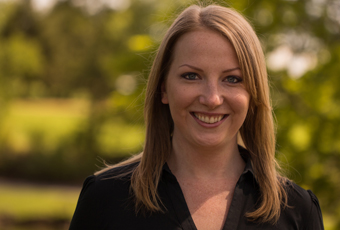
Sometimes the only thing standing in the way of success is doubt, according to Rhea Stadick, software developer and organizational coach at Intel. “Just assumptions that it can’t happen, it won’t happen, or there’s a rule against it,” she says.
There’s a lot less in your way than you think, she says, if you just have the courage to try something new.
For her TED talk, Stadick will discuss her efforts to bring a new management approach to software, one that focuses more on collaboration, adaptability and innovation rather than conformity, deadlines and “deliverables.” One that encourages “out-of-the-box” thinking. It’s called Agile Development, and it promises not only better programs for end users, but a better life for programmers.
“It’s about bringing humanity to the workplace,” says Stadick, sitting in her team room at Intel’s Jones Farm campus, where she oversees the company’s efforts to implement Agile management strategies. It seems especially odd to see robots positioned around her as she says this. But those robots – in essence stands with monitor screens – help to mimic face-to-face meetings with programmers who may be in other countries, part of Agile’s emphasis on direct communication. In and around the room there is a 3‑D printer, couches, and a large whiteboard with various Post-It notes on it, and ideas scribbled across its surface. A large wall-size window opens to trees, leaves waving in the wind.
It’s a breath of fresh air for programmers, to have such an open space that encourages individuality and creative problem-solving.
And it’s a stark contrast to the traditionally heavy-handed, bureaucratic and partitioned approach to software that defined the industry in the past, an approach infamously portrayed in the 1999 movie Office Space. Think exasperated engineers — “I am good at dealing with people!! Can’t you understand that?!” – separating developers from the company’s clients. Think Bill Lumbergh, handing out weekend work and enforcing cover sheets for TPS reports. Think Peter Gibbons, drowning in a sea of cubicles every morning, doing just enough work to not get hassled.
“Six-by-six cubicles are not necessarily what humans are designed to do,” Stadick says.
As a new software hire 10 years ago, she saw firsthand the frustrations of just correcting defects instead of preventing them, and spending “crazy hours” on the job and at home, just to achieve the same average success rate, never better.
“I saw how painful some of the ways we ran projects and teams were for people,” she says.
Today, with Agile Development, Stadick is hoping to drive change not just at Intel, but across the industry. Her success could not only revolutionize the way we lead our projects, but also the way we lead our lives.
There are still some obstacles, she concedes, not surprising when trying to uproot an assembly-line management strategy that hearkens back to the Model‑T. But Stadick has faith in her team.
“We work with the some of the most intelligent people in the world,” she says.
“We can do pretty amazing things; there’s not a lot of things holding us back.”